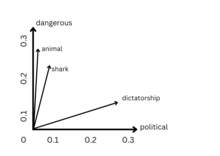분포 의미론
보이기

분포 의미론[1](Distributional semantics)은 대규모 언어 데이터 샘플에서 언어 항목 간의 의미적 유사성을 그 분포 특성을 기반으로 정량화하고 분류하기 위한 이론 및 방법을 개발하고 연구하는 연구 분야이다. 분포 의미론의 기본 아이디어는 소위 분포 가설로 요약될 수 있다. 유사한 분포를 갖는 언어 항목은 유사한 의미를 갖는다.
분포 가설
[편집]언어학의 분포 가설(distributional hypothesis)은 언어 사용의 의미론에서 파생된다. 즉, 동일한 맥락에서 사용되고 발생하는 단어는 유사한 의미를 나타내는 경향이 있다.[2]
"단어는 그것이 유지하는 회사에 의해 특징지어진다"는 근본적인 생각은 1950년대 존 루퍼트 퍼스에 의해 대중화되었다.[3]
분포 가설은 통계 의미론의 기초이다. 분포 가설은 언어학에서 시작되었지만[4] 이제는 특히 단어 사용의 맥락과 관련하여 인지과학에서 주목을 받고 있다.[5]
최근 수 년 동안 분포 가설은 언어 학습에서 유사성 기반 일반화 이론의 기초를 제공했다. 즉, 어린이가 유사한 단어의 분포를 통해 그 사용에 대해 일반화함으로써 이전에 거의 접하지 못했던 단어를 사용하는 방법을 알아낼 수 있다는 아이디어이다.[6][7]
분포 가설은 두 단어가 의미적으로 유사할수록 분포적으로 더 유사할 것이며 따라서 유사한 언어적 맥락에서 더 많이 발생하는 경향이 있음을 시사한다.
같이 보기
[편집]각주
[편집]- ↑ Lenci, Alessandro; Sahlgren, Magnus (2023). 《Distributional Semantics》. Cambridge University Press. ISBN 9780511783692.
- ↑ Harris 1954
- ↑ Firth 1957
- ↑ Sahlgren 2008
- ↑ McDonald & Ramscar 2001
- ↑ Gleitman 2002
- ↑ Yarlett 2008
출처
[편집]- Harris, Z. (1954). “Distributional structure”. 《Word》 10 (23): 146–162. doi:10.1080/00437956.1954.11659520.
- Firth, J.R. (1957). “A synopsis of linguistic theory 1930-1955”. 《Studies in Linguistic Analysis》: 1–32. Reprinted in F.R. Palmer, 편집. (1968). 《Selected Papers of J.R. Firth 1952-1959》. London: Longman.
- Lenci, Alessandro; Sahlgren, Magnus (2023). 《Distributional Semantics》. Cambridge University Press. ISBN 9780511783692.
- Sahlgren, Magnus (2008). “The Distributional Hypothesis” (PDF). 《Rivista di Linguistica》 20 (1): 33–53. 2012년 3월 15일에 원본 문서 (PDF)에서 보존된 문서. 2010년 12월 10일에 확인함.
- McDonald, S.; Ramscar, M. (2001). 〈Testing the distributional hypothesis: The influence of context on judgements of semantic similarity〉. 《Proceedings of the 23rd Annual Conference of the Cognitive Science Society》. 611–616쪽. CiteSeerX 10.1.1.104.7535.
- Gleitman, Lila R. (2002). 〈Verbs of a feather flock together II〉. 《The Legacy of Zellig Harris》. Current Issues in Linguistic Theory 1. 209–229쪽. doi:10.1075/cilt.228.17gle. ISBN 978-90-272-4736-0.
- Yarlett, D. (2008). 《Language Learning Through Similarity-Based Generalization》 (PDF) (학위논문). Stanford University. 2014년 4월 19일에 원본 문서 (PDF)에서 보존된 문서. 2012년 7월 12일에 확인함.
- Rieger, Burghard B. (1991). On Distributed Representations in Word Semantics (PDF) (보고서). ICSI Berkeley 12-1991. CiteSeerX 10.1.1.37.7976. 2024년 4월 27일에 원본 문서 (PDF)에서 보존된 문서. 2024년 3월 24일에 확인함.
- Deerwester, Scott; Dumais, Susan T.; Furnas, George W.; Landauer, Thomas K.; Harshman, Richard (1990). “Indexing by Latent Semantic Analysis” (PDF). 《Journal of the American Society for Information Science》 41 (6): 391–407. CiteSeerX 10.1.1.33.2447. doi:10.1002/(SICI)1097-4571(199009)41:6<391::AID-ASI1>3.0.CO;2-9. 2012년 7월 17일에 원본 문서 (PDF)에서 보존된 문서.
- Padó, Sebastian; Lapata, Mirella (2007). “Dependency-based construction of semantic space models”. 《Computational Linguistics》 33 (2): 161–199. doi:10.1162/coli.2007.33.2.161. S2CID 7747235.
- Schütze, Hinrich (1993). 〈Word Space〉. 《Advances in Neural Information Processing Systems 5》. 895–902쪽. CiteSeerX 10.1.1.41.8856.
- Sahlgren, Magnus (2006). 《The Word-Space Model》 (PDF) (학위논문). Stockholm University. 2012년 6월 19일에 원본 문서 (PDF)에서 보존된 문서. 2012년 11월 26일에 확인함.
- Thomas Landauer; Susan T. Dumais. “A Solution to Plato's Problem: The Latent Semantic Analysis Theory of Acquisition, Induction, and Representation of Knowledge”. 2007년 7월 2일에 확인함.
- Kevin Lund; Curt Burgess; Ruth Ann Atchley (1995). 《Semantic and associative priming in a high-dimensional semantic space》. Cognitive Science Proceedings. 660–665쪽.
- Kevin Lund; Curt Burgess (1996). “Producing high-dimensional semantic spaces from lexical co-occurrence”. 《Behavior Research Methods, Instruments, and Computers》 28 (2): 203–208. doi:10.3758/bf03204766.
